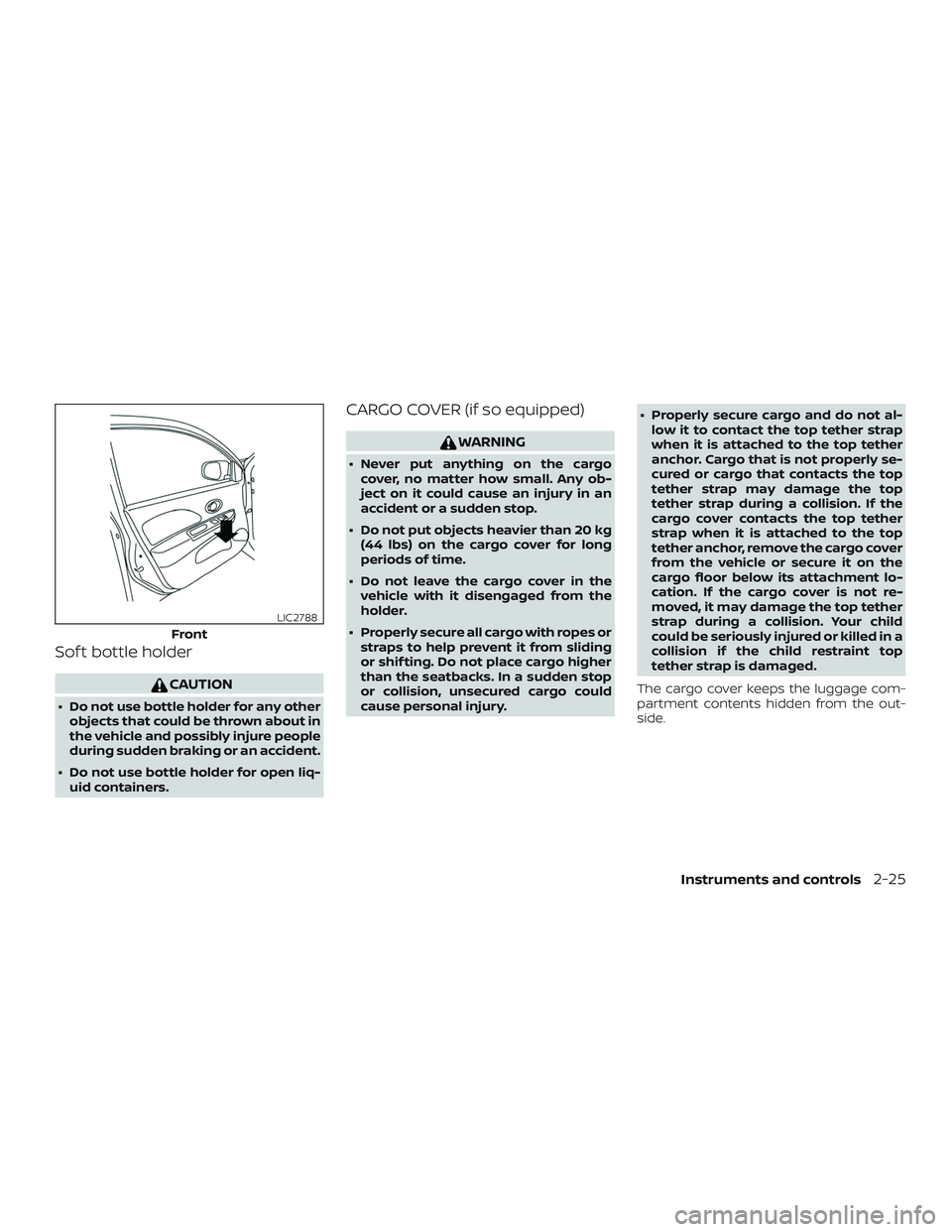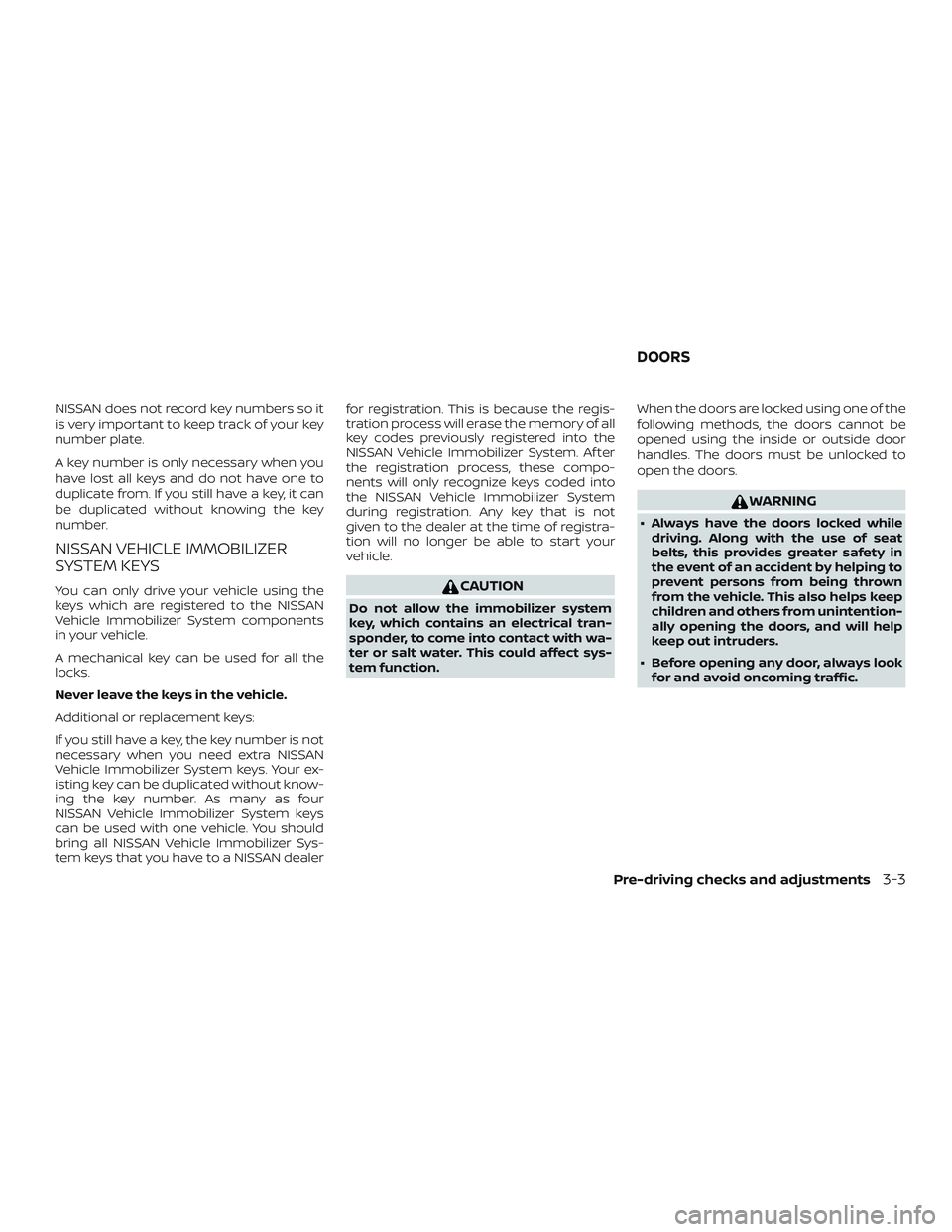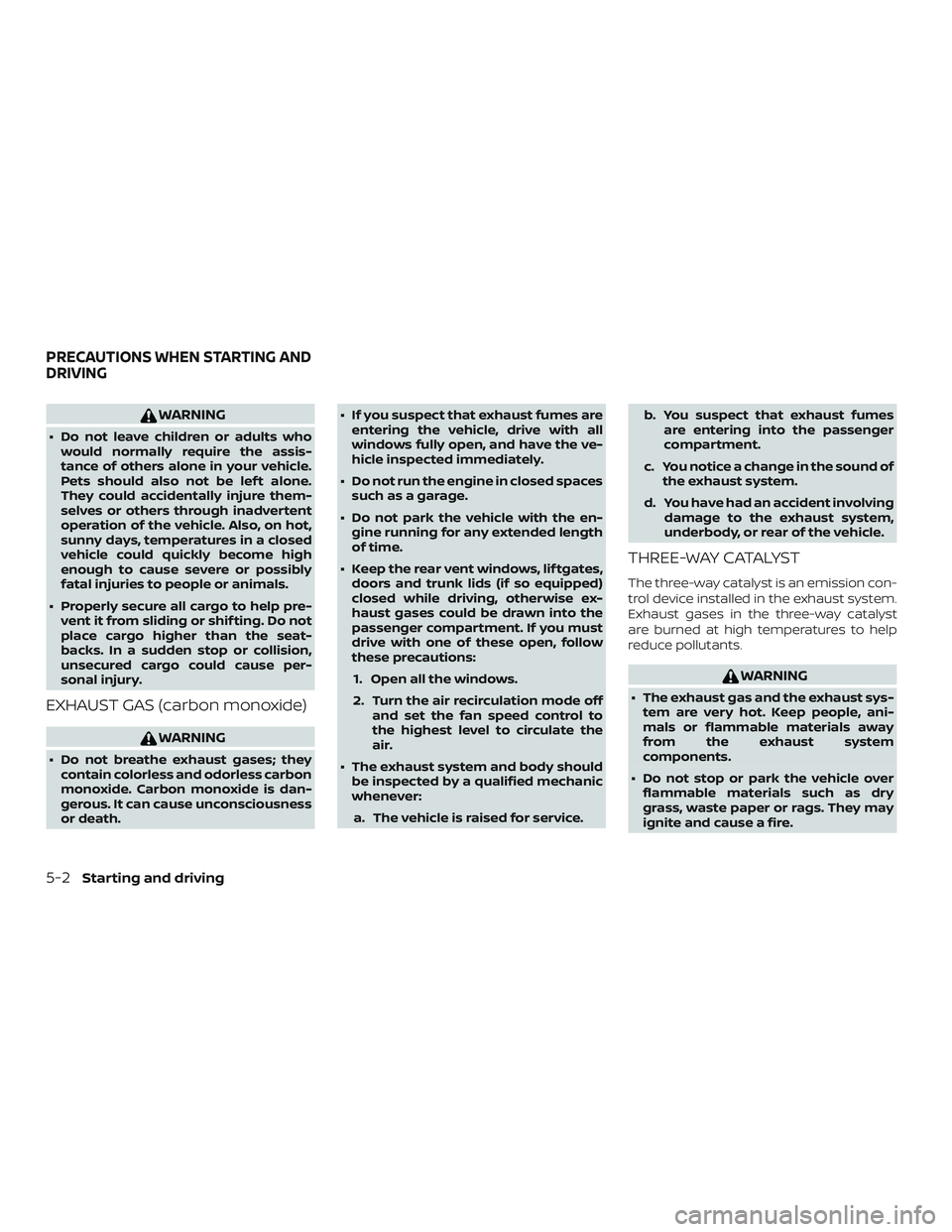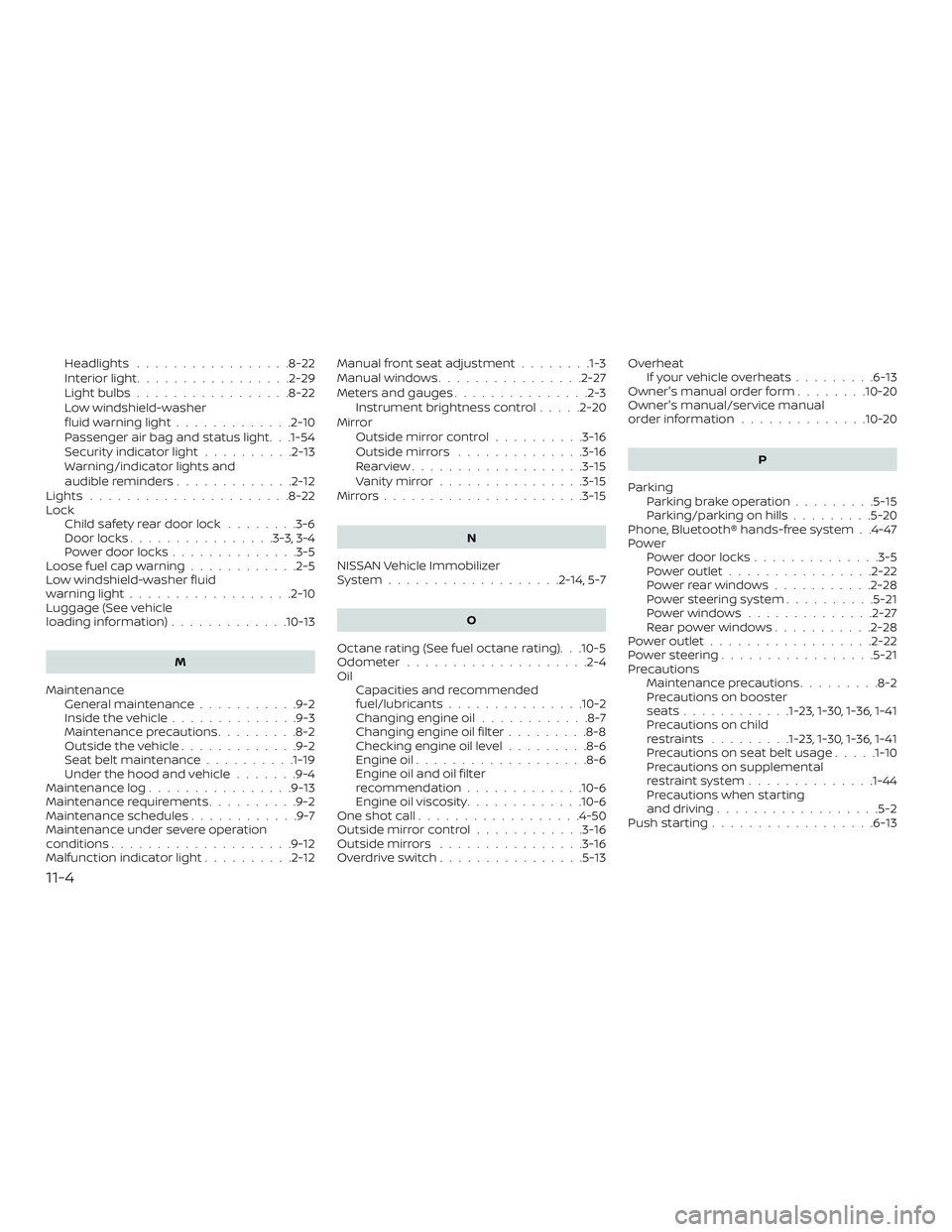2018 NISSAN MICRA child seat
[x] Cancel search: child seatPage 106 of 330

Sof t bottle holder
CAUTION
∙ Do not use bottle holder for any otherobjects that could be thrown about in
the vehicle and possibly injure people
during sudden braking or an accident.
∙ Do not use bottle holder for open liq- uid containers.
CARGO COVER (if so equipped)
WARNING
∙ Never put anything on the cargocover, no matter how small. Any ob-
ject on it could cause an injury in an
accident or a sudden stop.
∙ Do not put objects heavier than 20 kg (44 lbs) on the cargo cover for long
periods of time.
∙ Do not leave the cargo cover in the vehicle with it disengaged from the
holder.
∙ Properly secure all cargo with ropes or straps to help prevent it from sliding
or shif ting. Do not place cargo higher
than the seatbacks. In a sudden stop
or collision, unsecured cargo could
cause personal injury. ∙ Properly secure cargo and do not al-
low it to contact the top tether strap
when it is attached to the top tether
anchor. Cargo that is not properly se-
cured or cargo that contacts the top
tether strap may damage the top
tether strap during a collision. If the
cargo cover contacts the top tether
strap when it is attached to the top
tether anchor, remove the cargo cover
from the vehicle or secure it on the
cargo floor below its attachment lo-
cation. If the cargo cover is not re-
moved, it may damage the top tether
strap during a collision. Your child
could be seriously injured or killed in a
collision if the child restraint top
tether strap is damaged.
The cargo cover keeps the luggage com-
partment contents hidden from the out-
side.
Front
LIC2788
Instruments and controls2-25
Page 114 of 330

NISSAN does not record key numbers so it
is very important to keep track of your key
number plate.
A key number is only necessary when you
have lost all keys and do not have one to
duplicate from. If you still have a key, it can
be duplicated without knowing the key
number.
NISSAN VEHICLE IMMOBILIZER
SYSTEM KEYS
You can only drive your vehicle using the
keys which are registered to the NISSAN
Vehicle Immobilizer System components
in your vehicle.
A mechanical key can be used for all the
locks.
Never leave the keys in the vehicle.
Additional or replacement keys:
If you still have a key, the key number is not
necessary when you need extra NISSAN
Vehicle Immobilizer System keys. Your ex-
isting key can be duplicated without know-
ing the key number. As many as four
NISSAN Vehicle Immobilizer System keys
can be used with one vehicle. You should
bring all NISSAN Vehicle Immobilizer Sys-
tem keys that you have to a NISSAN dealerfor registration. This is because the regis-
tration process will erase the memory of all
key codes previously registered into the
NISSAN Vehicle Immobilizer System. Af ter
the registration process, these compo-
nents will only recognize keys coded into
the NISSAN Vehicle Immobilizer System
during registration. Any key that is not
given to the dealer at the time of registra-
tion will no longer be able to start your
vehicle.CAUTION
Do not allow the immobilizer system
key, which contains an electrical tran-
sponder, to come into contact with wa-
ter or salt water. This could affect sys-
tem function.
When the doors are locked using one of the
following methods, the doors cannot be
opened using the inside or outside door
handles. The doors must be unlocked to
open the doors.
WARNING
∙ Always have the doors locked while
driving. Along with the use of seat
belts, this provides greater safety in
the event of an accident by helping to
prevent persons from being thrown
from the vehicle. This also helps keep
children and others from unintention-
ally opening the doors, and will help
keep out intruders.
∙ Before opening any door, always look for and avoid oncoming traffic.
DOORS
Pre-driving checks and adjustments3-3
Page 189 of 330

WARNING
∙ Do not leave children or adults whowould normally require the assis-
tance of others alone in your vehicle.
Pets should also not be lef t alone.
They could accidentally injure them-
selves or others through inadvertent
operation of the vehicle. Also, on hot,
sunny days, temperatures in a closed
vehicle could quickly become high
enough to cause severe or possibly
fatal injuries to people or animals.
∙ Properly secure all cargo to help pre- vent it from sliding or shif ting. Do not
place cargo higher than the seat-
backs. In a sudden stop or collision,
unsecured cargo could cause per-
sonal injury.
EXHAUST GAS (carbon monoxide)
WARNING
∙ Do not breathe exhaust gases; theycontain colorless and odorless carbon
monoxide. Carbon monoxide is dan-
gerous. It can cause unconsciousness
or death. ∙ If you suspect that exhaust fumes are
entering the vehicle, drive with all
windows fully open, and have the ve-
hicle inspected immediately.
∙ Do not run the engine in closed spaces such as a garage.
∙ Do not park the vehicle with the en- gine running for any extended length
of time.
∙ Keep the rear vent windows, lif tgates, doors and trunk lids (if so equipped)
closed while driving, otherwise ex-
haust gases could be drawn into the
passenger compartment. If you must
drive with one of these open, follow
these precautions:
1. Open all the windows.
2. Turn the air recirculation mode off and set the fan speed control to
the highest level to circulate the
air.
∙ The exhaust system and body should be inspected by a qualified mechanic
whenever:
a. The vehicle is raised for service. b. You suspect that exhaust fumes
are entering into the passenger
compartment.
c. You notice a change in the sound of the exhaust system.
d. You have had an accident involving damage to the exhaust system,
underbody, or rear of the vehicle.
THREE-WAY CATALYST
The three-way catalyst is an emission con-
trol device installed in the exhaust system.
Exhaust gases in the three-way catalyst
are burned at high temperatures to help
reduce pollutants.
WARNING
∙ The exhaust gas and the exhaust sys-tem are very hot. Keep people, ani-
mals or flammable materials away
from the exhaust system
components.
∙ Do not stop or park the vehicle over flammable materials such as dry
grass, waste paper or rags. They may
ignite and cause a fire.
PRECAUTIONS WHEN STARTING AND
DRIVING
5-2Starting and driving
Page 321 of 330

CD player (See audio system)....4-34,4-39
Childrestraints........1-20, 1-21, 1-23, 1-25 LATCH (Lower Anchors and Tethers
forCHildren)System ...........1-25
Precautions on child
restraints .........1-23, 1-30, 1-36, 1-41
Top tether strap anchor point
locations.................. .1-28
Child safety rear door lock ..........3-6
Chimes, audible reminders .........2-14
Cleaningexteriorandinterior......7-2,7-4
Clockset.................4-33,4-38
Clutch Clutchfluid.................8-10
C.M.V.S.S. certification label .........10-11
Coldweatherdriving.............5-26
Compact disc (CD) player .......4-34,4-39
Controls Audio controls (steering wheel) ....4-45
Heater and air conditioner controls . .4-15
Coolant Capacities and recommended
fuel/lubricants...............10-2
Changing engine coolant .........8-5
Checking engine coolant level ......8-5
Corrosionprotection..............7-7
Cruisecontrol..................5-16
Cupholders...............2-24,2-25
Curtain side-impact and rollover
airbag......................1-60
D
Daytime light system .............2-19 Defroster switch
Rear window and outside mirror
defrosterswitch..............2-18
Dimensions and weights ...........10-9
Dimmer switch for instrument panel . . .2-20
Door locks ..................3-3,3-4
Door open warning light ...........2-10
Drivebelt ....................8-14
Driving Cold weather driving ...........5-26
Driving with automatic transmission . .5-9
Driving with manual transmission . . .5-13
Precautions when starting and
driving.....................5-2
Drivingthevehicle ...............5-9
E
Economy - fuel .................5-19
Emission control information label . . . .10-11
Emission control system warranty . . . .10-18
Engine Before starting the engine ........5-7
Blockheater................5-28
Capacities and recommended
fuel/lubricants...............10-2
Changing engine coolant .........8-5
Changing engine oil ............8-7
Changing engine oil filter .........8-8
Checking engine coolant level ......8-5
Checking engine oil level .........8-6
Engine compartment check
locations...................8-3
Engine cooling system ..........8-4
Engine oil ...................8-6 Engine oil and oil filter
recommendation
.............10-6
Engine oil pressure warning light . . . .2-10
Engine oil viscosity .............10-6
Engine serial number ...........10-11
Engine specifications ...........10-8
Starting the engine .............5-8
EventDatarecorders............10-20
Exhaust gas (Carbon monoxide) .......5-2
Explanation of maintenance items .....9-2
Explanation of scheduled maintenance
items .......................9-5
Extended storage switch ..........8-20
F
Flashers (See hazard
warningflasherswitch)............6-2
Flattire......................6-2
Floormatpositioningaid...........7-6
Fluid Automatic transmission fluid (ATF) . . .8-9
Brakefluid..................8-9
Capacities and recommended
fuel/lubricants...............10-2
Clutchfluid.................8-10
Engine coolant ...............8-4
Engine oil ...................8-6
Front air bag system (See
supplemental restraint system) ......1-54
Front-door pocket ...............
2
-23
Frontseats....................1-2
Fuel Capacities and recommended
fuel/lubricants...............10-2
11-2
Page 323 of 330

Headlights .................8-22
Interiorlight.................2-29
Lightbulbs.................8-22
Low windshield-washer
fluidwarninglight.............2-10
Passenger air bag and status light. . .1-54
Security indicator light..........2-13
Warning/indicator lights and
audible reminders .............2-12
Lights ......................8-22
Lock Child safety rear door lock ........3-6
Door locks ................3-3,3-4
Power door locks ..............3-5
Loose fuel cap warning ............2-5
Low windshield-washer fluid
warninglight..................2-10
Luggage (See vehicle
loading information) .............10-13
M
Maintenance General maintenance ...........9-2
Insidethevehicle..............9-3
Maintenance precautions .........8-2
Outsidethevehicle.............9-2
Seat belt maintenance ..........1-19
Under the hood and vehicle .......9-4
Maintenance log ................9-13
Maintenance requirements ..........9-2
Maintenance schedules ............9-7
Maintenance under severe operation
conditions....................9-12
Malfunctionindicatorlight..........2-12 Manual front seat adjustment
........1-3
Manual windows ................2-27
Meters and gauges ...............2-3
Instrument brightness control .....2-20
Mirror Outsidemirrorcontrol..........3-16
Outsidemirrors ..............3-16
Rearview...................3-15
Vanitymirror................3-15
Mirrors......................3-15
N
NISSAN Vehicle Immobilizer
System...................2-14,5-7
O
Octane rating (See fuel octane rating). . .10-5
Odometer ....................2-4
Oil Capacities and recommended
fuel/lubricants...............10-2
Changing engine oil ............8-7
Changing engine oil filter .........8-8
Checking engine oil level .........8-6
Engine oil ...................8-6
Engine oil and oil filter
recommendation .............10-6
Engine oil viscosity .............10-6
One shot call ..................4-50
Outsidemirrorcontrol............3-16
Outsidemirrors ................3-16
Overdriveswitch................5-13 Overheat
Ifyourvehicleoverheats.........6-13
Owner's manual order form ........10-20
Owner's manual/service manual
orderinformation..............10-20
P
Parking Parking brake operation .........5-15
Parking/parkingonhills.........5-20
Phone, Bluetooth® hands-free system . .4-47
Power Power door locks ..............3-5
Poweroutlet................2-22
Powerrearwindows...........2-28
Power steering system ..........5-21
Powerwindows..............2-27
Rearpowerwindows...........2-28
Poweroutlet..................2-22
Powersteering................ .5-21
Precautions Maintenance precautions .........8-2
Precautions on booster
seats............1-23, 1-30, 1-36, 1-41
Precautions on child
restraints .........1-23, 1-30, 1-36, 1-41
Precautionsonseatbeltusage.....1-10
Precautions on supplemental
r e
straintsystem..............1-44
Precautions when starting
anddriving..................5-2
Push starting ..................6-13
11-4
Page 324 of 330

R
Radio Car phone or CB radio ..........4-47
FM/AM radio with compact disc (CD)
player.................4-31,4-36
Steering wheel audio
controlswitch...............4-45
Readiness for inspection maintenance
(I/M)test....................10-19
Rearcenterseatbelt .............1-16
Rearhatch....................3-10
Rearpowerwindows.............2-28
Rearseat.....................1-5
Rearviewmirror ................3-15
RearViewMonitor................4-2
Rear window and outside mirror
defrosterswitch................2-18
Rear window wiper and washer
switches .....................2-17
Recommended Fluids ............10-2
Recorders EventData.................10-20
Refrigerant recommendation ........10-7
Registering a vehicle in another
country .....................10-10
Remote keyless entry system ......3-6,3-7
Reporting safety defects (US only) . . . .10-19
S
Safety Child safety rear door lock ........3-6
Childseatbelts......1-23, 1-30, 1-36, 1-41
Reporting safety defects (US only) . .10-19 Seat adjustment
Front manual seat adjustment ......1-3
Rear seat adjustment ...........1-5
Seat belt Childsafety.................1-20
Infants and small children ........1-21
InjuredPerson............... .1-13
Largerchildren.............. .1-21
Precautions on seat belt usage .....1-10
Pregnant women ..............1-13
Rearcenterseatbelt ...........1-16
Seat belt extenders ............1-19
Seat belt maintenance ..........1-19
Seatbelts................1-10, 7-6
Shoulder belt height adjustment . . . .1-19
Three-pointtypewithretractor.....1-13
Seat belt extenders ..............1-19
Seatbeltwarninglight..........1-13, 2-11
Seats Adjustment ..................1-2
Frontseats..................1-2
Manual front seat adjustment ......1-3
Rearseat...................1-5
Security indicator light ............2-13
Security system (NISSAN Vehicle
Immobilizer System), engine start . . .2-14, 5-7
Security systems Vehicle security system .........2-14
Self-adjustingbrakes.............8-17
Service manual order form .........10-20
Servicing air conditioner ...........4-23
Shif ting Automatic transmission .........5-10
Manual transmission ...........5-14
Shiftlockrelease................5-12
Shoulder belt height adjustment ......1-19Side air bag system (See supplemental
side air bag, curtain and rollover air bag
s
y
stems).....................1-60
Spark plug replacement ...........8-14
Spark plugs ...................8-14
Specifications .................10-8
Speedometer ..................2-4
Speedometer and odometer ........2-4
SRS warning label ...............1-62
Stability control ................5-24
Standard maintenance ............9-8
Starting Before starting the engine ........5-7
Jumpstarting.............6 -11, 8-13
Precautions when starting
anddriving..................5-2
Push starting ................6-13
Starting the engine .............5-8
Starting the engine ...............5-8
Steering Power steering system ..........5-21
Tilting steering wheel ...........3-14
Steering wheel .................3-14
Steering wheel audio control switch . . .4-45
Stoplight....................8-27
Storage.....................2-23
Storagetray ..................2-23
Sunvisors....................3-14
Supplemental air bag warning labels . . .1-62
Supplemental air bag warning
light.................... .1-63, 2-11
Supplemental front impact air bag
system......................1-54
Supplemental restraint system Information and warning labels . . . .1-62
11-5